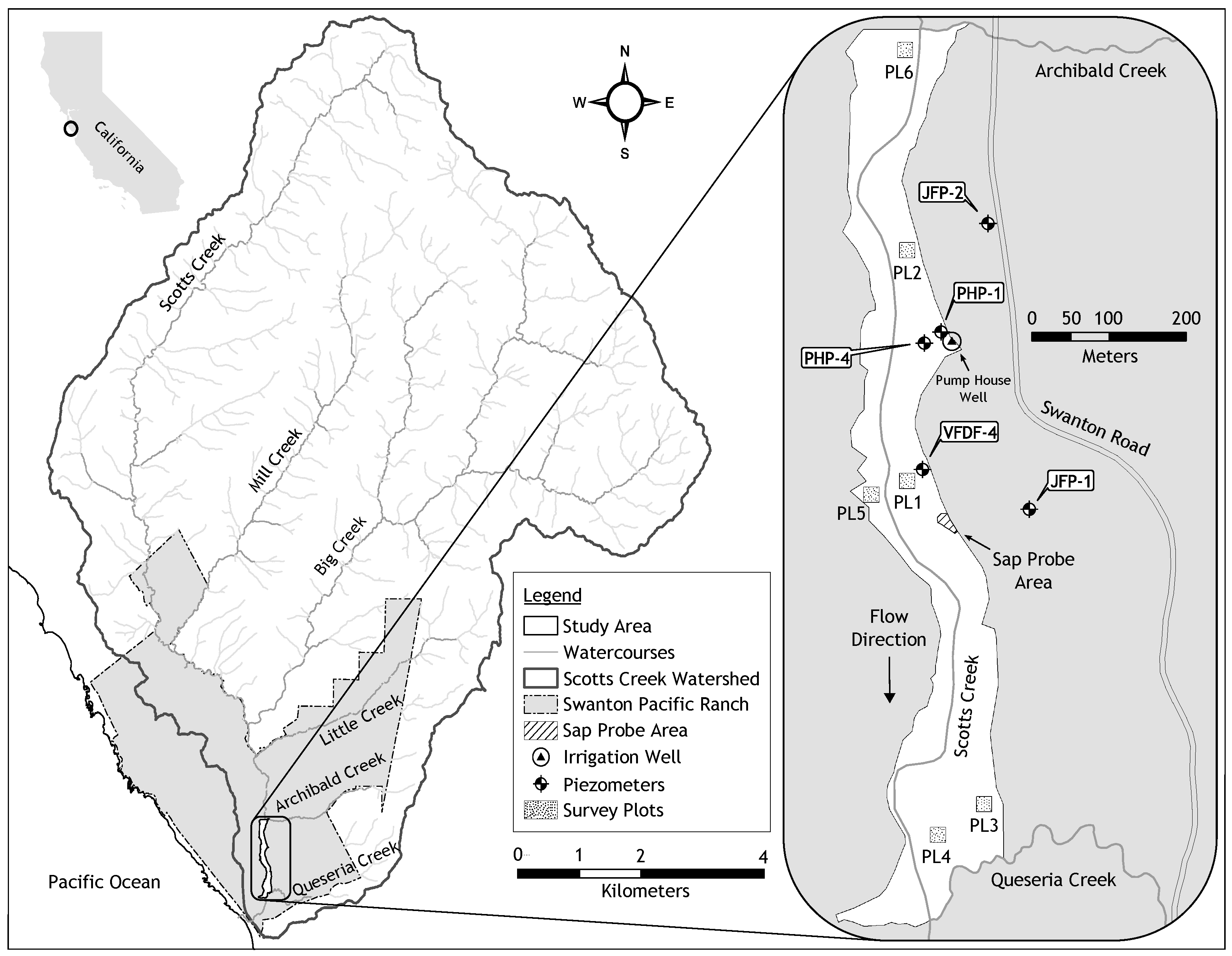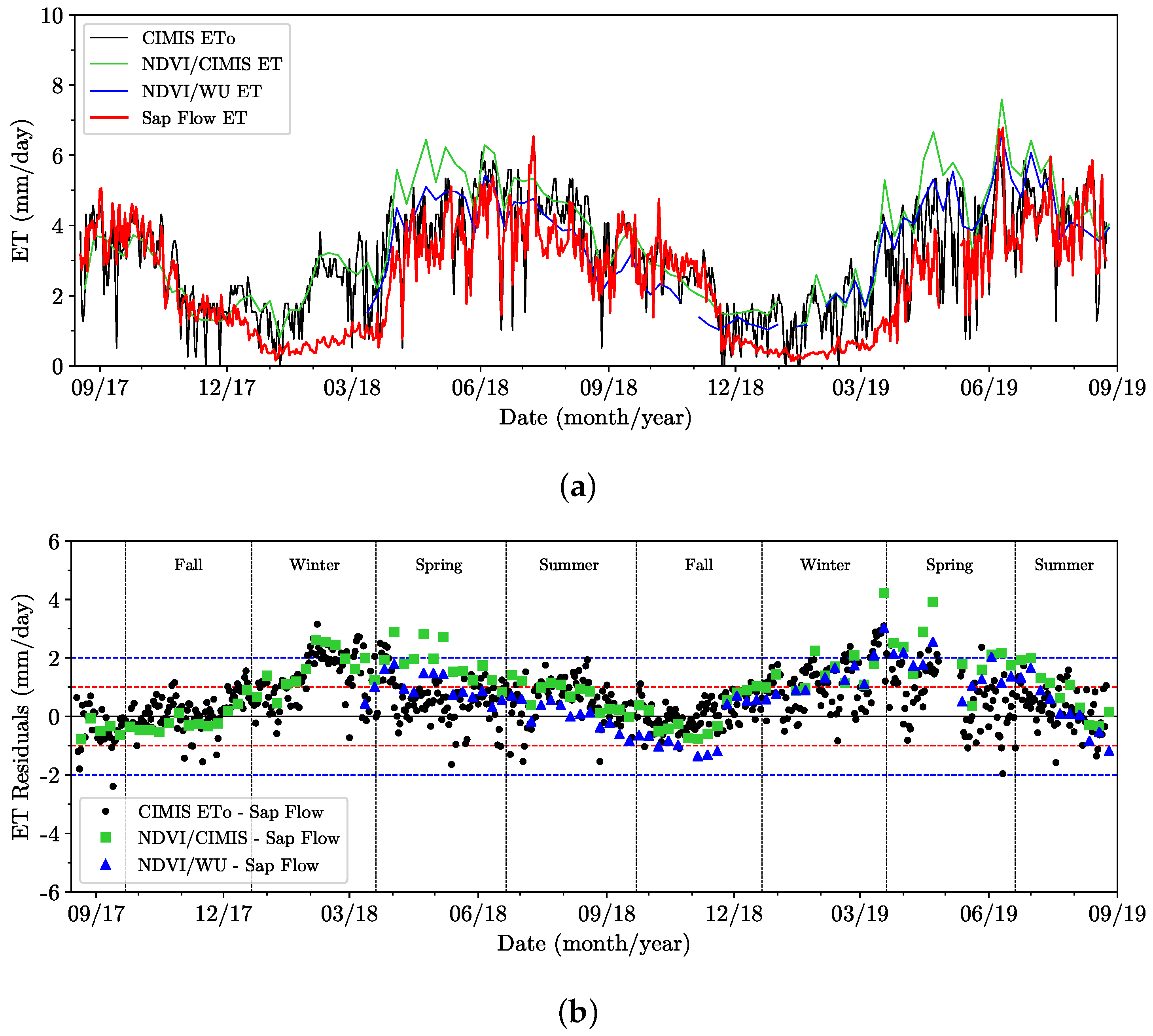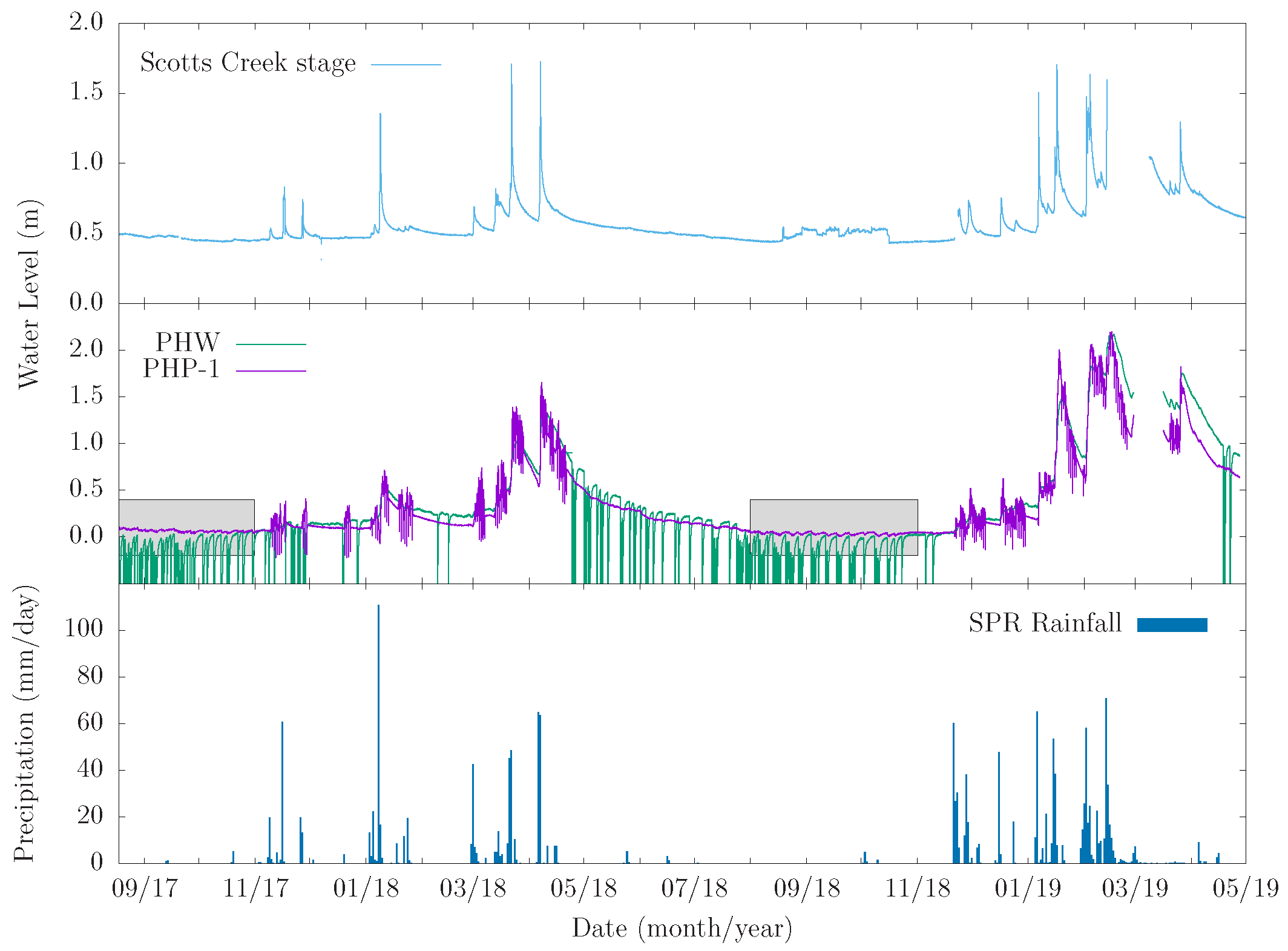Estimating Canopy-Scale Evapotranspiration from Localized Sap Flow Measurements
Abstract
:1. Introduction
2. Materials and Methods
2.1. Study Site
2.2. Sap Flow Measurements
2.3. Measurement and Estimation of Tree Diameter and Sapwood Depth
2.4. Upscaling Plot Measurements to Forest Scale
2.5. Validation Method
3. Results
3.1. Phreatophytic Vegetation Survey and Sapwood Area
3.2. Sap Flow Measurements
3.3. Evapotranspiration of Riparian Forest
3.4. Comparison with Groundwater Pumping for Irrigation
4. Discussion
5. Conclusions
Author Contributions
Funding
Institutional Review Board Statement
Informed Consent Statement
Data Availability Statement
Acknowledgments
Conflicts of Interest
Abbreviations
| CIMIS | California Irrigation Management Information System |
| DBH | Diameter at breast height |
| ESRI | Environmental Systems Research Institute |
| ET | Evapotranspiration |
| ETo | Reference evapotranspiration |
| eMODIS | EROS Moderate Resolution Imaging Spectroradiometer |
| HPV | Heat Pulse Velocity |
| NDVI | Normalized difference vegetative index |
| THB | Tissue Heat Balance |
| TDP | Thermal Dissipation Probe(s) |
| VPD | Vapor Pressure Deficit |
| WU | Weather Underground |
References
- Snider, B.; Urquhart, K.A.F.; Marston, D. The Relationship between Instream Flow and Coho Salmon and Steelhead Habitat Availability in Scott Creek, Santa Cruz County, California; Technical Report; California Department of Fish and Game, Environmental Services Division, Stream Flow and Habitat Evaluation Program: Redding, CA, USA, 1995.
- Welsch, D.J. Riparian Forest Buffers—Function and Design for Protection and Enhancement of Water Resources; U.S. Department of Agriculture, Forest Service, Northeastern Area, State & Private Forestry, Forest Resources Management: Washington, DC, USA, 1991.
- Jordan, T.E.; Correll, D.L.; Weller, D.E. Nutrient interception by a riparian forest receiving inputs from adjacent cropland. J. Environ. Qual. 1993, 22, 467–473. [Google Scholar] [CrossRef] [Green Version]
- Schultz, R.C.; Isenhart, T.M.; Colletti, J.P. Riparian buffer systems in crop and rangelands. Nat. Resour. Ecol. Manag. Conf. Pap. Posters Present. 2005, 23, 13–28. [Google Scholar]
- Gribovszki, Z.; Kalicz, P.; Szilágyi, J.; Kucsara, M. Riparian zone evapotranspiration estimation from diurnal groundwater level fluctuations. J. Hydrol. 2008, 349, 6–17. [Google Scholar] [CrossRef]
- Robinson, T.W. Phreatophytes; Water-Supply Paper 1423; U.S. Geological Survey: Washington, DC, USA, 1958.
- Naumburg, E.; Mata-Gonzalez, R.; Hunter, R.G.; Mclendon, T.; Martin, D.W. Phreatophytic vegetation and groundwater fluctuations: A review of current research and application of ecosystem response modeling with an emphasis on Great Basin vegetation. Environ. Manag. 2005, 35, 726–740. [Google Scholar] [CrossRef] [PubMed]
- Rood, S.B.; Bigelow, S.G.; Hall, A.A. Root architecture of riparian trees: River cut-banks provide natural hydraulic excavation, revealing that cottonwoods are facultative phreatophytes. Trees 2011, 25, 907–917. [Google Scholar] [CrossRef]
- Malama, B.; Johnson, B. Analytical modeling of saturated zone head response to evapotranspiration and river-stage fluctuations. J. Hydrol. 2010, 382, 1–9. [Google Scholar] [CrossRef]
- Scott, R.L.; Shuttleworth, W.J.; Goodrich, D.C.; Maddock, T., III. The water use of two dominant vegetation communities in a semiarid riparian ecosystem. Agric. For. Meteorol. 2000, 105, 241–256. [Google Scholar] [CrossRef]
- Goodrich, D.C.; Scott, R.; Qi, J.; Goff, B.; Unkrich, C.L.; Moran, M.S.; Williams, D.; Schaeffer, S.; Snyder, K.; MacNish, R.; et al. Seasonal estimates of riparian evapotranspiration using remote and in situ measurements. Agric. For. Meteorol. 2000, 105, 281–309. [Google Scholar] [CrossRef]
- Loheide, S.P., II; Butler, J.J., Jr.; Gorelick, S.M. Estimation of groundwater consumption by phreatophytes using diurnal water table fluctuations: A saturated-unsaturated flow assessment. Water Resour. Res. 2005, 41, W07030. [Google Scholar] [CrossRef]
- Johnson, B.; Malama, B.; Barrash, W.; Flores, A.N. Recognizing and modeling variable drawdown due to evapotranspiration in a semiarid riparian zone considering local differences in vegetation and distance from a river source. Water Resour. Res. 2013, 49, 1030–1039. [Google Scholar] [CrossRef] [Green Version]
- Granier, A. Une nouvelle méthode pour la mesure du flux de sève brute dans le tronc des arbres. Ann. Des Sci. For. 1985, 42, 193–200. [Google Scholar] [CrossRef]
- Granier, A.; Biron, P.; Bréda, N.; Pontailler, J.Y.; Saugier, B. Transpiration of trees and forest stands: Short and long-term monitoring using sapflow methods. Glob. Chang. Biol. 1996, 2, 265–274. [Google Scholar] [CrossRef]
- Moore, G.W.; Bond, B.J.; Jones, J.A.; Phillips, N.; Meinzer, F.C. Structural and compositional controls on transpiration in 40-and 450-year-old riparian forests in western Oregon, USA. Tree Physiol. 2004, 24, 481–491. [Google Scholar] [CrossRef] [Green Version]
- Moore, G.W.; Bond, B.J.; Jones, J.A. A comparison of annual transpiration and productivity in monoculture and mixed-species Douglas-fir and red alder stands. For. Ecol. Manag. 2011, 262, 2263–2270. [Google Scholar] [CrossRef]
- Moore, G.W.; Bond, B.J.; Jones, J.A.; Meinzer, F.C. Thermal-dissipation sap flow sensors may not yield consistent sap-flux estimates over multiple years. Trees 2010, 24, 165–174. [Google Scholar] [CrossRef]
- Bidlack, J.E.; Jansky, S.H. Stern’s Introductory Plant Biology, 12th ed.; McGraw-Hill: London, UK, 2011; p. 622. [Google Scholar]
- Malama, B.; Pritchard-Peterson, D.; Jasbinsek, J.J.; Surfleet, C. Assessing Stream-Aquifer Connectivity in a Coastal California Watershed. Water 2021, 13, 416. [Google Scholar] [CrossRef]
- Cook, B.O. Lower Scotts Creek Floodplain and Habitat Enhancement Project. Master’s Thesis, California Polytechnic State University, San Luis Obispo, CA, USA, 2016. [Google Scholar]
- Louen, J.M. Hydrologic Characteristics of Summer Stream Temperatures in Little Creek and Scotts Creek at the Swanton Pacific Ranch. Master’s Thesis, California Polytechnic State University, San Luis Obispo, CA, USA, 2016. [Google Scholar]
- West, J. Traversing Swanton Road. 2016. Available online: https://arboretum.ucsc.edu/pdfs/traversin-gswanton.pdf (accessed on 20 April 2022).
- Kutscha, N.P.; Sachs, I.B. Color Tests for Differentiating Heartwood and Sapwood in Certain Softwood Tree Species; Report 2246; U.S. Department of Agriculture, Forest Service, Forest Products Laboratory: Washington, DC, USA, 1962.
- Moore, G.W.; Aparecido, L.M.T.; Discussion of Safranin Dye injection Apparatus for Red Alders. Personal Communication, 2019.
- Bamber, R.K. Sapwood and Heartwood; Technical Publication 2; Forestry Commission of New South Wales, Wood Technology and Forest Research Division: Beecroft, NSW, Australia, 1987.
- Oishi, A.C.; Oren, R.; Stoy, P.C. Estimating components of forest evapotranspiration: A footprint approach for scaling sap flux measurements. Agric. For. Meteorol. 2008, 148, 1719–1732. [Google Scholar] [CrossRef] [Green Version]
- Avery, T.E.; Burkhart, H.E. Forest Measurements, 5th ed.; McGraw-Hill: London, UK, 2002. [Google Scholar]
- Schaeffer, S.M.; Williams, D.G.; Goodrich, D.C. Transpiration of cottonwood/willow forest estimated from sap flux. Agric. For. Meteorol. 2000, 105, 257–270. [Google Scholar] [CrossRef]
- Penman, H.L. Natural evaporation from open water, bare soil and grass. Proc. R. Soc. Lond. Ser. A Math. Phys. Sci. 1948, 193, 120–145. [Google Scholar]
- Doorenbos, J.; Pruitt, W.O. Guidelines for Predicting Crop Water Requirements; FAO Irrigation and Drainage Paper 24; Food and Agriculture Organization of the United Nations: Rome, Italy, 1977. [Google Scholar]
- Allen, R.G.; Pereira, L.S.; Raes, D.; Smith, M. Crop Evapotranspiration–Guidelines for Computing Crop Water Requirements; FAO Irrigation and Drainage Paper 56; Food and Agriculture Organization of the United Nations: Rome, Italy, 1998. [Google Scholar]
- Bisht, G.; Venturini, V.; Islam, S.; Jiang, L.E. Estimation of the net radiation using MODIS (Moderate Resolution Imaging Spectroradiometer) data for clear sky days. Remote Sens. Environ. 2005, 97, 52–67. [Google Scholar] [CrossRef]
- Lillesand, T.M.; Kiefer, R.W.; Chipman, J.W. Remote Sensing and Image Interpretation, 6th ed.; John Wiley & Sons, Inc.: Hoboken, NJ, USA, 2008; p. 756. [Google Scholar]
- Batra, N.; Islam, S.; Venturini, V.; Bisht, G.; Jiang, L.E. Estimation and comparison of evapotranspiration from MODIS and AVHRR sensors for clear sky days over the Southern Great Plains. Remote Sens. Environ. 2006, 103, 1–15. [Google Scholar] [CrossRef]
- Jenkerson, C.; Maiersperger, T.; Schmidt, G. eMODIS: A User-Friendly Data Source; Open-File Report 2010–1055; U.S. Geological Survey: Washington, DC, USA, 2010.
- Goldstein, G.; Andrade, J.L.; Meinzer, F.C.; Holbrook, N.M.; Cavelier, J.; Jackson, P.; Celis, A. Stem water storage and diurnal patterns of water use in tropical forest canopy trees. Plant Cell Environ. 1998, 21, 397–406. [Google Scholar] [CrossRef]
- Carrasco, O.L.; Bucci, S.J.; Di Francescantonio, D.; Lezcano, O.A.; Campanello, P.I.; Scholz, F.G.; Rodríguez, S.; Madanes, N.; Cristiano, P.M.; Hao, G.Y.; et al. Water storage dynamics in the main stem of subtropical tree species differing in wood density, growth rate and life history traits. Tree Physiol. 2015, 35, 354–365. [Google Scholar] [CrossRef] [PubMed] [Green Version]
- Pritchard-Peterson, D. Field Investigation of Stream-Aquifer Interactions: A Case Study in Coastal California. Master’s Thesis, California Polytechnic State University, San Luis Obispo, CA, USA, 2018. [Google Scholar]
- Köstner, B.; Granier, A.; Čermák, J. Sapflow measurements in forest stands: Methods and uncertainties. Ann. Des Sci. For. 1998, 55, 13–27. [Google Scholar] [CrossRef]
- Wullschleger, S.D.; Childs, K.W.; King, A.W.; Hanson, P.J. A model of heat transfer in sapwood and implications for sap flux density measurements using thermal dissipation probes. Tree Physiol. 2011, 31, 669–679. [Google Scholar] [CrossRef] [Green Version]
- Loheide, S.P., II. A method for estimating subdaily evapotranspiration of shallow groundwater using diurnal water table fluctuations. Ecohydrol. Ecosyst. Land Water Process Interact. Ecohydrogeomorphol. 2008, 1, 59–66. [Google Scholar] [CrossRef]
- Butler, J.J., Jr.; Kluitenberg, G.J.; Whittemore, D.O.; Loheide, S.P., II; Jin, W.; Billinger, M.A.; Zhan, X. A field investigation of phreatophyte-induced fluctuations in the water table. Water Resour. Res. 2007, 43. [Google Scholar] [CrossRef] [Green Version]
- Szilágyi, J.; Gribovszki, Z.; Kalicz, P.; Kucsara, M. On diurnal riparian zone groundwater-level and streamflow fluctuations. J. Hydrol. 2008, 349, 1–5. [Google Scholar] [CrossRef] [Green Version]
- Gribovszki, Z.; Szilágyi, J.; Kalicz, P. Diurnal fluctuations in shallow groundwater levels and streamflow rates and their interpretation—A review. J. Hydrol. 2010, 385, 371–383. [Google Scholar] [CrossRef] [Green Version]












| Species | DBH (cm) | Sapwood Area (cm) | ||||
|---|---|---|---|---|---|---|
| n | n | |||||
| Red Alder | 83 (24) | 20.9 (31.6) | 15.0 (17.0) | 23 | 734.0 | 543.1 |
| Arroyo Willow | 61 (16) | 11.6 (19.6) | 7.5 (6.6) | 14 | 318.4 | 140.7 |
| Pacific Willow | 9 (6) | 27.5 (28.6) | 10.4 (11.5) | 5 | 526.2 | 347.7 |
| Species | Bark Thickness | Heartwood/Pith Radius | Estimates | ||||||||||
|---|---|---|---|---|---|---|---|---|---|---|---|---|---|
| n | n | n | (m/ha) | (m) | |||||||||
| R-Alder | 24 | Exp | 0.220 | 0.030 | 0.698 | 23 | Exp | 0.067 | 0.050 | 0.241 | 83 | 16.4 | 150.5 |
| A-Willow | 16 | Exp | 0.194 | 0.041 | 0.674 | 16 | Linear | 0.192 | −2.214 | 0.454 | 61 | 3.3 | 30.3 |
| P-Willow | 6 | Exp | 0.331 | 0.042 | 0.690 | 5 | Linear | 0.045 | 0.207 | 0.333 | 9 | 2.1 | 19.3 |
| Season | Arroyo Willow | Red Alders | Riparian Forest | ||
|---|---|---|---|---|---|
| 1 | 2 | 3 | |||
| Summer 2017 2 | |||||
| Fall 2017 | |||||
| Winter 2018 | |||||
| Spring 2018 | |||||
| Summer 2018 | |||||
| Fall 2018 | |||||
| Winter 2019 | |||||
| Spring 2019 2 | |||||
| Summer 2019 2 | |||||
| Sap | CIMIS | NDVI | ||
|---|---|---|---|---|
| Season | Flow | CIMIS | WU | |
| Summer 2017 2 | - | |||
| Fall 2017 | - | |||
| Winter 2018 | - | |||
| Spring 2018 | ||||
| Summer 2018 | ||||
| Fall 2018 | ||||
| Winter 2019 | ||||
| Spring 2019 2 | ||||
| Summer 2019 2 | ||||
| Method | w/ Winter Data | w/o Winter Data | ||
|---|---|---|---|---|
| Slope | Slope | |||
| CIMIS ETo | 1.103 | 0.911 | 1.081 | 0.953 |
| NDVI/CIMIS | 1.260 | 0.893 | 1.237 | 0.932 |
| NDVI/WU | 1.135 | 0.914 | 1.136 | 0.938 |
Publisher’s Note: MDPI stays neutral with regard to jurisdictional claims in published maps and institutional affiliations. |
© 2022 by the authors. Licensee MDPI, Basel, Switzerland. This article is an open access article distributed under the terms and conditions of the Creative Commons Attribution (CC BY) license (https://creativecommons.org/licenses/by/4.0/).
Share and Cite
Solum, J.; Malama, B. Estimating Canopy-Scale Evapotranspiration from Localized Sap Flow Measurements. Water 2022, 14, 1812. https://doi.org/10.3390/w14111812
Solum J, Malama B. Estimating Canopy-Scale Evapotranspiration from Localized Sap Flow Measurements. Water. 2022; 14(11):1812. https://doi.org/10.3390/w14111812
Chicago/Turabian StyleSolum, James, and Bwalya Malama. 2022. "Estimating Canopy-Scale Evapotranspiration from Localized Sap Flow Measurements" Water 14, no. 11: 1812. https://doi.org/10.3390/w14111812
APA StyleSolum, J., & Malama, B. (2022). Estimating Canopy-Scale Evapotranspiration from Localized Sap Flow Measurements. Water, 14(11), 1812. https://doi.org/10.3390/w14111812






